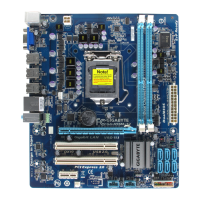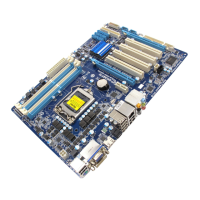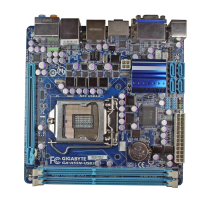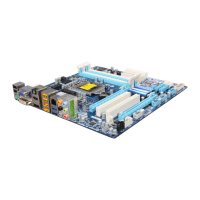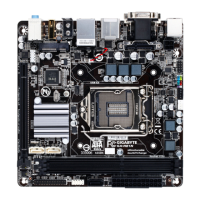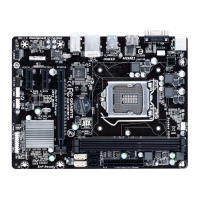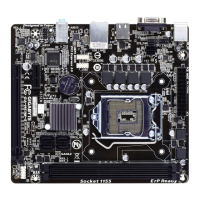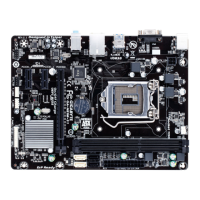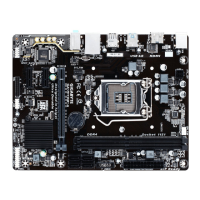Do you have a question about the Gigabyte GA-H55M-S2V and is the answer not in the manual?
Lists items included in the motherboard packaging.
Lists optional accessories available for purchase.
Diagram showing physical component locations on the motherboard.
Illustrates internal connections and data flow.
Safety guidelines to prevent damage during installation.
Details about CPU, memory, expansion slots, and connectivity.
Step-by-step guide for CPU installation into the socket.
Instructions for attaching the CPU cooling solution.
Guide on how to install RAM modules correctly.
Procedure for installing cards into PCI/PCIe slots.
Description of ports available on the motherboard's rear panel.
Identification and function of internal headers and connectors.
Displays information shown during system boot-up.
Overview of the BIOS Setup main interface and navigation.
Settings for CPU, memory, and voltage adjustments.
Configuration of system date, time, and basic hardware.
Settings for boot order, security, and system capabilities.
Configuration of onboard devices like SATA, USB, and LAN.
Options for system power states and energy saving.
Monitoring of system temperatures, voltages, and fan speeds.
Resets BIOS to the safest, most stable factory settings.
Resets BIOS to optimal performance factory settings.
Manages BIOS access passwords for security.
Saves BIOS changes and exits the setup utility.
Discards BIOS changes and exits the setup utility.
Guide to installing essential motherboard chipset drivers.
Lists GIGABYTE utilities and free software for installation.
Provides access to guides and documentation for drivers.
Information on how to contact GIGABYTE support.
Displays basic system information and hardware details.
Links to GIGABYTE website for latest BIOS and driver updates.
Provides links to install recently developed GIGABYTE utilities.
Utility for system data backup and restoration.
Tools (Q-Flash, @BIOS) for updating the motherboard BIOS.
Software for fine-tuning system performance and overclocking.
Tool for easy data sharing between computers on a network.
Feature to save system power using a Bluetooth cell phone.
Setup guide for multi-channel audio configurations.
Adjusting audio environment and effects.
Instructions for enabling older audio modules.
Guide to mute rear audio outputs when front headphones are used.
Steps to set up and use the microphone input.
Guide on how to use the built-in sound recording utility.
Answers to common user queries and issues.
Step-by-step guide to diagnose and resolve startup problems.
Information on product compliance and environmental directives.
Primary contact details for global headquarters.
Contact information for German branch.
| Non-ECC | Yes |
|---|---|
| Memory voltage | 1.5 V |
| Number of memory slots | 2 |
| Maximum internal memory | 16 GB |
| Supported memory clock speeds | 800, 1066, 1333, 1600, 1800, 2200 MHz |
| Processor socket | LGA 1156 (Socket H) |
| Processor manufacturer | Intel |
| Compatible processor series | Intel® Pentium® |
| Processor system buses supported | 800, 1066, 1333, 1600 MHz |
| Number of SATA III connectors | 6 |
| Number of Parallel ATA connectors | 1 |
| BIOS type | AWARD |
| ACPI version | 1.0b |
| BIOS memory size | 16 Mbit |
| Headphone outputs | 3 |
| USB 2.0 ports quantity | 8 |
| Firewire (IEEE 1394) ports | 0 |
| Audio chip | Realtek ALC888B |
| Component for | - |
| Power source type | ATX |
| Motherboard chipset | Intel® H55 |
| Audio output channels | 7.1 channels |
| Motherboard form factor | micro ATX |
| Compatible operating systems | Windows 7/Vista/XP |
| Parallel processing technology support | Not supported |
| Bundled software | Norton Internet Security (OEM) |
| LAN controller | Realtek RTL8111E |
| Networking features | 10/100/1000 Mbit |
| Ethernet interface type | Gigabit Ethernet |
| Depth | 210 mm |
|---|---|
| Width | 244 mm |
